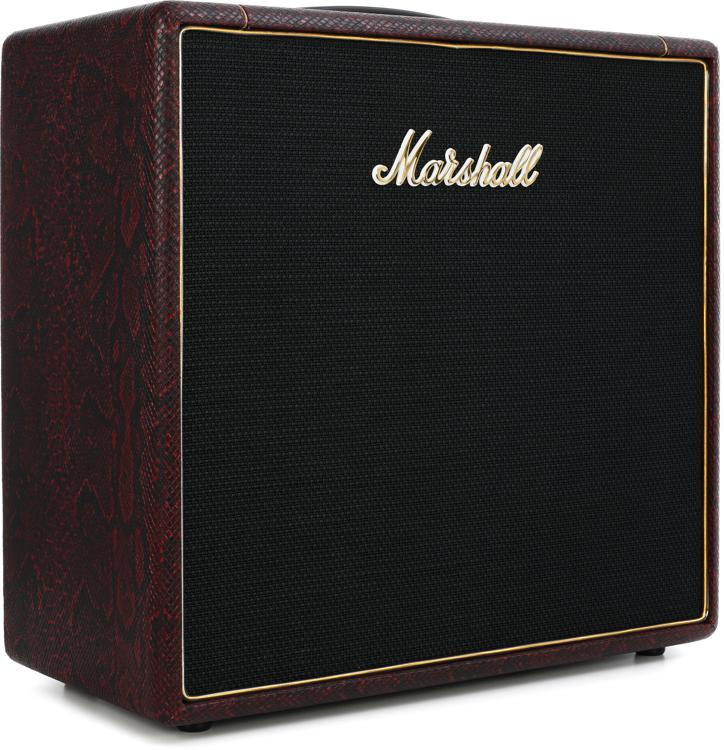


#Red marshall cabinet full#
Plug into the low input and you have to run the preamp and master volume controls near maximum before you can discern any breakup with single coils.Įach amp is of course powered by a pair of E元4sĮven then, it’s more of a warm harmonic enhancement than overdrive per se, and it certainly enhances the SC20C’s full and loud clean tone. However, that’s not necessarily what it’s all about. Predictably, the SC20C produces loads more preamp distortion than the SV20H – if that’s what you want. The high and low inputs behave as expected – albeit with a significant difference in level between them – and there is no necessity to go to extremes with any of the equalisation controls in order to dial in a usable tone. Turning our attention to the Studio Classic SC20C combo, everything feels familiar and straightforward once again. Once it’s dialled in, the SV20H becomes a simple and effective vintage-rock tone machine. For cleaner tones, the SV20H responds superbly when guitar volume is dialled back. After exploring the SV20H’s extremes, we find ourselves setting it up for general-purpose overdrive and using pedals for extra sustain and level when soloing. Overall, we prefer blending the normal channel with the classic crunch of the high treble side’s low-level input, but others may prefer the grainier and grittier character that comes from the high-level input. At lower levels, however, lifting the midrange sounds more like a treble boost. For instance, turning up high treble loudness 1 boosts midrange as well as volume and the middle control can provide scoop for a more contemporary heavy-rock tone. The controls are interactive, too, and much depends on the loudness settings. With a wider frequency spread to bite into, the equalisation controls also exert a massive influence. With both channels engaged, the individual loudness controls allow you to balance the low and upper midrange and focus overdrive on specific frequency areas. In this full-frequency mode, we can tap into the SV20H’s potential. Now, when the loudness 1 control is turned up, a crunchy upper midrange enhances the normal channel’s smooth and weighty overdrive character and makes up for any shortcomings.
#Red marshall cabinet Patch#
The solution is to plug your guitar into the normal channel’s high input and connect a patch cable between its low input and either input of the high treble channel. There’s much to like about the normal channel’s scale and fullness of tone, but even with single coils there’s a lack of cut in the upper mids. That’s certainly not the case when using input two on the SV20H’s high treble channel, but both normal channel inputs sound rather dark unless the treble and presence controls are set near the top of their ranges. There are various reasons why players began linking the channels on classic Marshalls, but we’ve often found it necessary when neither channel quite cuts it individually. Now we discover the full throated and crystalline cleans, and thick classic-rock overdrive, that are so uniquely Marshall in sound and spirit. Moving to the ‘low sensitivity’ input two allows us to push the treble and presence controls beyond 9 o’clock and everything begins to make sense. Two channels and four inputs provide a lot of tonal options on the SV20H Unpotted vintage-style P-90s and PAFs begin squealing before you can even play a note and our vintage Strat – which is by no means a bright-sounding example – induces more aural pain than pleasure. Plugging into the high treble channel’s input one alone, the SV20H proves to be probably the brightest-sounding amp we have ever encountered.

And linking or ‘jumping’ the channels is the key to unleashing its full potential, but more on that later. It’s only after a considerable amount of time spent struggling with the SV20H’s tone and presence controls that we even consider plugging into the low input, but the relief is considerable, because it reveals that there is a pedigree Marshall lurking inside. Never before have we found using an amplifier’s ‘low’ inputs preferable to using its ‘high’ inputs, but there’s a first time for everything. Traditionally on an amplifier such as this, input one is high-sensitivity and input two is low-sensitivity. Both units are extremely well finished, with immaculate Tolex coverings and very neat piping. The centre position puts the circuit in standby mode, while switching upwards sets power at five watts, and switching downwards selects the 20-watt mode. Although they look different, the standby switches on both of these amplifiers work in the same way.


 0 kommentar(er)
0 kommentar(er)
